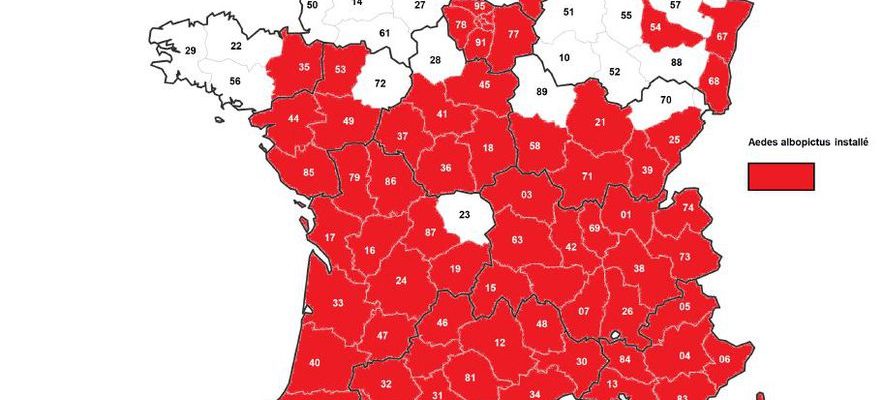Although most of the time it is not serious, dengue fever can cause severe headaches, vomiting, high fever and, in rare cases of dengue hemorrhagic fever, can lead to fatal shock. . Originally, the disease is transmitted by tiger mosquito bites in tropical and subtropical regions.
Tiger mosquitoes installed in France
In theory, therefore, the tiger mosquito lives in a hot and humid urban environment and likes stagnant water points around homes. The female bites during the day to feed and then transmits the virus if she is infected. However, since 2004, the tiger mosquito has settled in France. As of January 1, 2023, health authorities identified 71 departments classified as “red alert”, four more departments than at the same time the previous year.
departments where the tiger mosquito is established on January 1, 2023
© / Public health France
The arrival of these mosquitoes was made possible due to the females’ predilection for laying eggs in vehicle tires. Their eggs resist lack of water and the larvae have the ability to slow down their metabolism when temperature conditions are unfavorable. Thanks to the highways, from year to year, tiger mosquitoes move north. Another aggravating factor: global warming. The warmer it is, the shorter the mosquito’s development cycle. The speed of multiplication of the virus inside the insect also increases, under the effect of temperature.
More and more cases of “autochthonous dengue fever”
The effects of their presence are increasingly noticeable. In 2010 in Nice, the first 2 indigenous cases of dengue fever were detected. A case is defined as indigenous when the person contracts the disease without having traveled to an endemic area in the 15 days preceding the appearance of symptoms, according to Public Health France. These individuals were bitten, in France, by a tiger mosquito, itself infected after taking blood from a patient.
From year to year, the number of “native” infections has slowly increased, reaching a record in 2022, with 65 cases. Indigenous transmissions last year alone exceeded the total number of cases identified in the period between 2010 and 2021 (65 cases, compared to 48). Experts expect a comparable 2023 result, as the season is not yet over. They also encourage preparation for a growing threat. France had nine “outbreaks” last year, and eight, so far, this year.
Until now, only the southernmost departments of the country were affected by outbreaks of autochthonous dengue fever. Except that for the first time, a case was spotted in Île-de-France in October, in Limeil-Brévannes (Val-de-Marne), about fifteen kilometers southeast of Paris. “This is the most northern case in France, and even in Europe, ever recorded,” said Dr Marie-Claire Paty, coordinator of vector-borne disease surveillance at Public Health France.
Overseas, the Antilles have been in an epidemic phase since mid-August, and health authorities are monitoring profiles at risk of serious forms, in particular patients with sickle cell anemia. This epidemic has contributed to the 1,300 cases of dengue imported so far into France, a record. The health authorities will therefore have to be extra vigilant during the 2024 Olympic Games, which will encourage the mixing of populations in the middle of the summer season.
